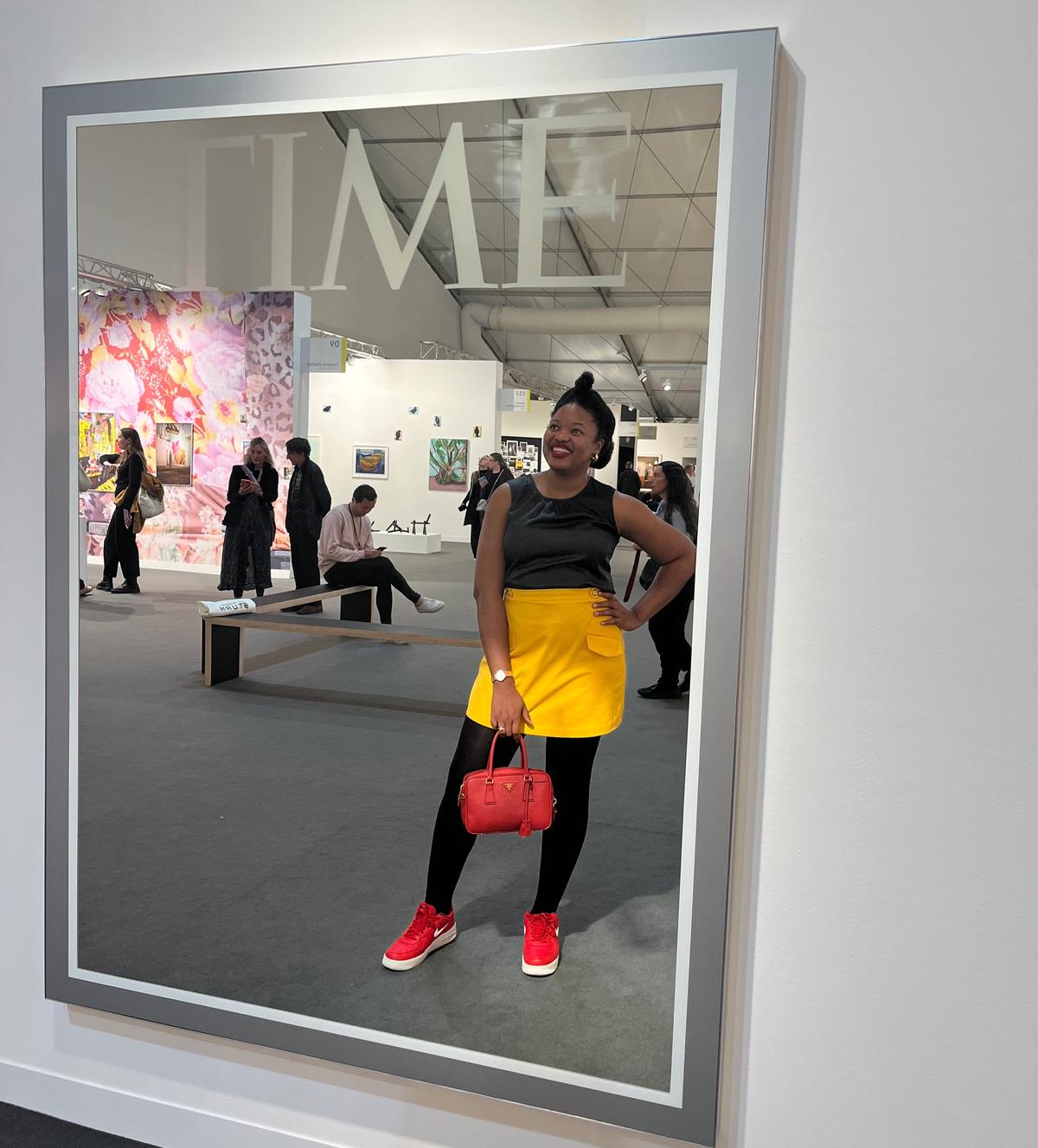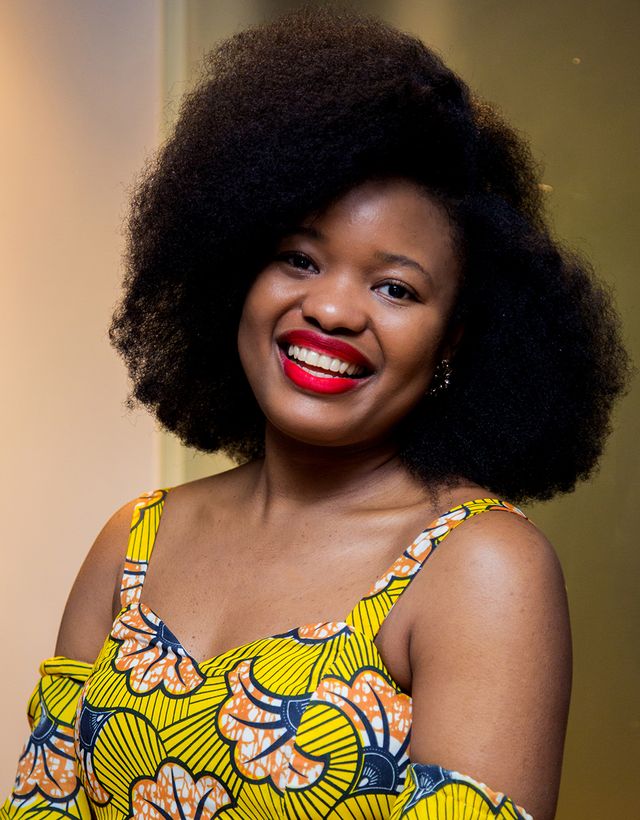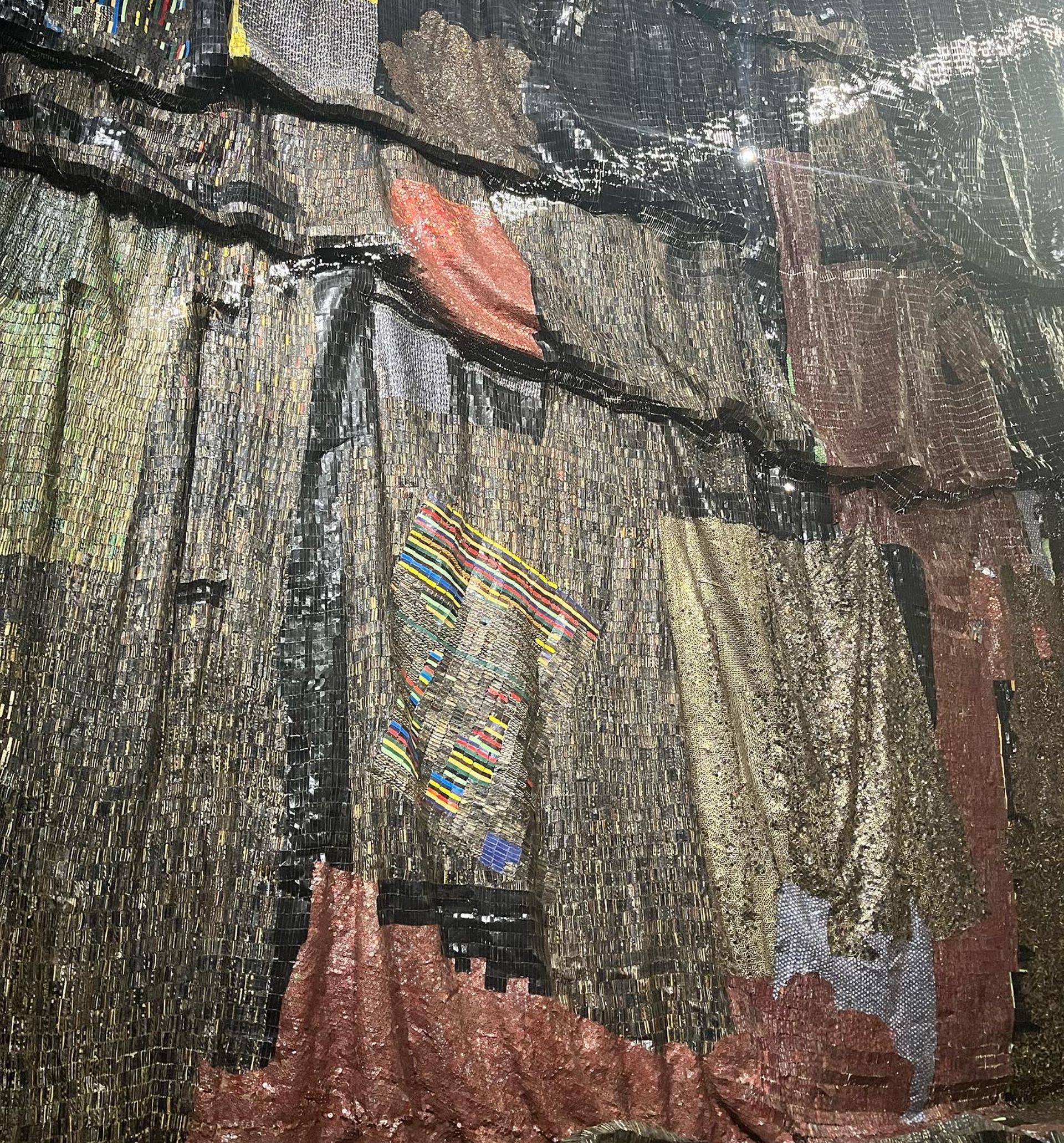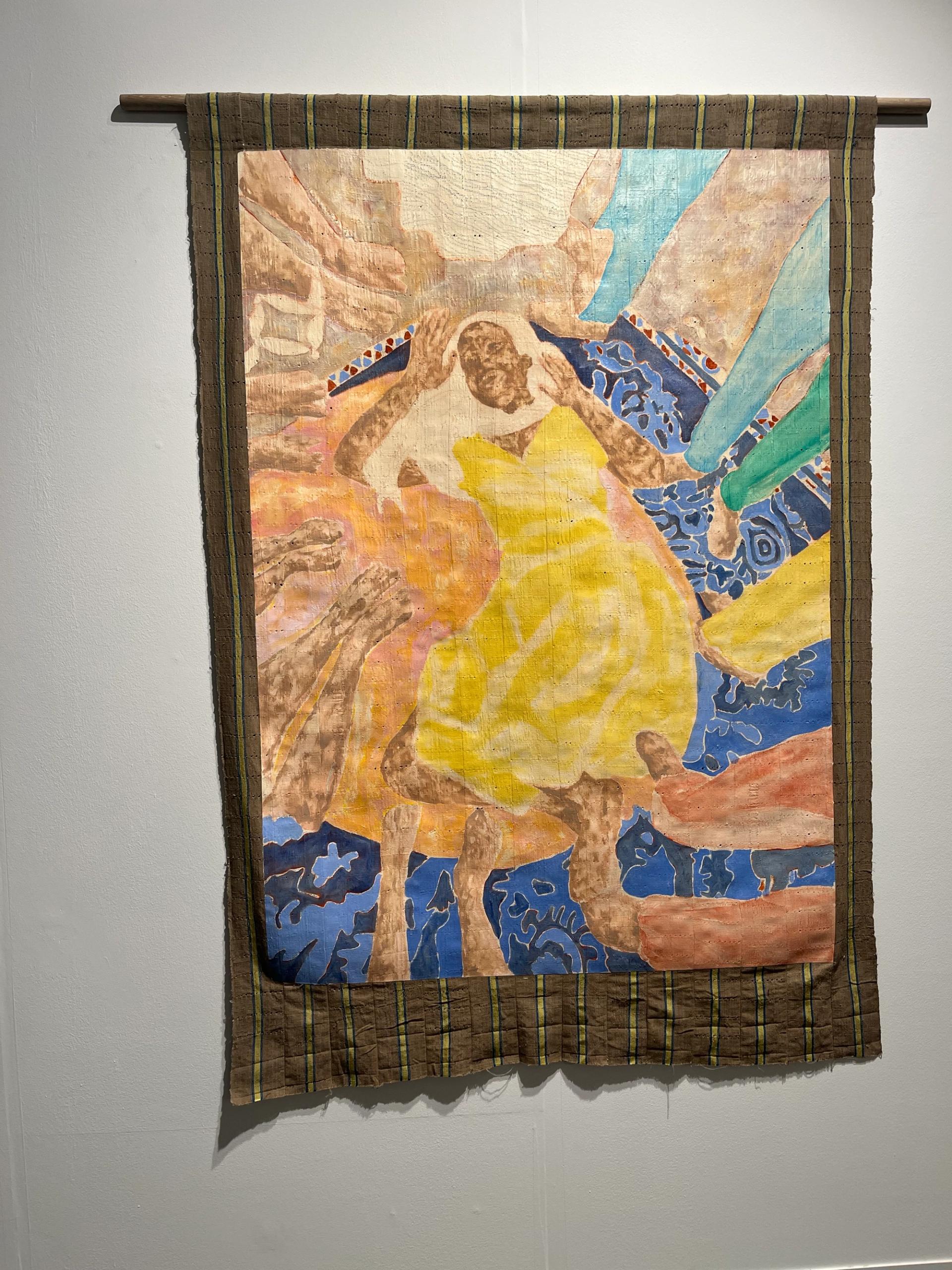Slade to Zaria | ||||
Chibundu Onuzo, a novelist and fellow of the Royal Society of Literature, shares her reflections on the contemporary art world. | ||||
|
'The art fair is a market, not a museum'
As this year's calendar gets under way—next stops, Delhi and Los Angeles—Chibundu Onuzo reflects on her experience at Frieze London to assess what these global events offer

Dress for duress: Chibundu Onuzo sports the ideal footwear and luggage for Frieze weekChibundu Onuzo

Slade to Zaria—which refers to the prominent art schools in London and Nigeria—is a contemporary art column by Chibundu Onuzo, a novelist and fellow of the Royal Society of Literature.
My Frieze week began in a queue. Specifically, I was queuing to get into Yinka Shonibare’s most recent exhibition: Free the Wind, the Spirit and the Sun.
“Are you here for the opening?” I asked the last person in line. Surely, there was a night club next door.
“Yes,” they replied.
“We’re doing crowd control,” the doorman of the Stephen Friedman Gallery said as he pushed back overly keen art lovers.
Some of us in the queue were better connected than others. After only a few seconds of waiting, these chosen ones were plucked from the line and whisked indoors. I looked forlornly through the floor to ceiling windows. I could see the party but I couldn’t join it. Surely this was a metaphor for the art world. Outsiders standing with their noses pressed against the glass, while insiders refused to make space by leaving.
Forget egalitarianism
After 30 minutes, when it was finally my turn, the doorman announced, “The exhibition is closing soon. No more entries.” At which point I said to myself, “Down with egalitarianism!” I called an artist friend who was already inside, and he got me in.
Who goes to an opening to see art? You go to get a selfie with the artist
And was the exhibition worth the queue? Yes, even though I had to go a second time to appreciate Shonibare’s surreal and playful vision. My favourite piece was the sculpture Feeling Free like a Bird (2023). In this piece, a mannequin in a dress rides a life-size horse covered in a vibrant print that is usually called ‘African’. Strapped to her back are cages with their doors sprung open. Birds perch around these open cages. They are free but they have not flown away because freedom takes many steps.
Of course, I didn’t notice all these details on my first viewing. Who goes to an opening to see art? You go to get a selfie with the artist. And some free drinks if there are any. And, of course, you go to an opening to say art matters and art is worth giving up an evening for, even if you have to queue in the cold.
Small talk and air kissing
My next stop was another opening: this time, El Anatsui’s Turbine Hall installation at Tate Modern: Behind the Red Moon. I planned on being fashionably late but, thanks to Transport for London, I ended up just being late, late. I missed Anatsui’s speech and the drumming and dancing but there was still plenty to see—and I’m not just talking about the art, which was monumental, and colossal and which I will of course have to see again properly.

El Anatsui’s Tate Modern Turbine Hall installation, Behind the Red MoonChibundu Onuzo
I spotted writers, artists, curators, gallerists and collectors like Irenosen Okojie, Sokari Douglas Camp, Nana Oforiatta-Ayim, Adora Mba, Oba Nsugbe (the chair of The Africa Centre), and on and on. I air kissed like my life depended on it. I small talked with vim and vigour. I even got my photo taken by a roving journalist. I finally felt like an art-world insider! I knew the feeling was going to be short-lived but I savoured it anyway.
Next stop was breakfast the next morning at Thaddaeus Ropac to celebrate Daniel Richter’s new exhibition: Stupor. I’d vaguely heard of the gallery and I hadn’t heard of the artist but they were offering breakfast and a new experience.
The gallery itself is a grand dame of a building. With its high ceilings and lofty central staircase, the architecture almost stole the show. “One of the most beautiful buildings in London,” I heard someone whisper in awe. Another guest went on about the window treatments and how she had similar windows at home.
The gallery was full of people wearing black and wielding Chanel bags. Never had quiet luxury screamed so loudly
There is much appetite for Richter’s work as evinced by the high turnout on a Tuesday morning. The gallery was full of people wearing black and wielding Chanel bags like shields. Never had quiet luxury screamed so loudly.
Richter himself was present, tall and good humoured. When a gallery director spent too long introducing his work, he interjected with a blunt and good-natured ‘Enough of the flattery!”
Punch-you-in-the-retina red
The paintings stopped you in your tracks. The red was the first thing I saw: pulsating, vibrant, punch-you-in-the-retina red. When I saw Richter’s red, words like ‘incarnadine’ sprang to my mind. And then I noticed the figures surrounded by all this crimson: alien, distorted, mangled, loose-skinned figures that both repulsed and fascinated. The body of work is accomplished and tonally cohesive but it was almost too cohesive. After wandering through room after room of Richter’s paintings, the eye needed somewhere to rest from all that red. And so I popped in quickly to see Joy Labinjo’s latest exhibition at Tiwani: Beloved, Take What You need.
Labinjo’s treatment of Black skin is almost Cubist in style
Labinjo’s paintings are tender family moments that draw the viewer in. Her treatment of Black skin is almost Cubist in style. Her subjects literally embody the muti-faceted nature of blackness.
One or two paintings veered into the sentimental for me but, for the most part, Labinjo’s paintings strike the emotions cleanly. I lingered in front of a painting called Aunty Bukky. A young Black woman holds a newborn baby. She is smartly dressed and her gaze rests lightly on the viewer. The image is still and quiet. Yoruba Madonna, I thought to myself, as I contemplated.
Sensible shoes and a small handbag
All this art, and I hadn’t actually been to Frieze yet. Did I have the mental and physical stamina to make it to the main event, or would I drop out from exhaustion?
“What to wear to Frieze,” I typed into my search engine when I discovered I’d snagged a press ticket to one of the biggest art fairs in the world. The internet advised I wear sensible shoes and carry a small handbag. Confident with my sartorial choices, I made my way to Regent’s Park.
As I approached the big tent, I noticed the crowd walking alongside me. It felt like we were on our way to a football match, except that nobody was chanting. My first impression of Frieze had nothing to do with art. Instead, words like ‘throng’, ‘multitude’ and ‘agoraphobe,’ filled my mind. I stood at the entrance and surveyed the booths that stretched into the distance. I almost couldn’t see the art for all the people. Where to begin? My friend and I decided to turn right and see what came of it.
The layout seemed at war with the objective of viewing art
Everything, everywhere all at once
The venue, it seemed, was designed to look bland. With grey carpet, white walls and no windows, there was nothing to view except the art. And yet, strangely, the layout seemed at war with the objective of viewing art. Few booths were enclosed and from most vantage points, you could see everything, everywhere all at once. While each gallery curated their offerings, they had no control over what was shown next door, and so the effect was often visually jarring. In one glance, one’s eye might take in a painting, an installation and a sculpture, all vying for your attention.
Booths that managed to cocoon viewers from the visual cacophony proved to be the most memorable. Some, like Victoria Miro, had the floor space to erect temporary walls that created narrow corridors of art. Thus, I was able to have a quiet moment with a Celia Paul self-portrait that was calm, beautiful and wise. There were religious undertones to the serene woman who stared back at me.
The presentation of Larry Achiampong’s work at the Copperfield booth was inspired
To stand out, other booths turned themselves into destinations, where the art wasn’t just viewed but also experienced. The presentation of Larry Achiampong’s work at the Copperfield booth was inspired. Achiampong’s paintings of video-game avatars are both fun and serious. The figures confront the viewer in their fight pose, while the text accompanying them reminds the viewer of who is often left out of video-game imagery. In addition to the paintings, there was a comfy sofa, some Supermalt bottles, a retro television and a few game consoles to help you relive your childhood. The experience was immersive, and I saw many visitors getting lost in their gaming.
Not a smile, not a greeting
The atmosphere in Frieze was very business-like. Perhaps, because of the volume of people that passed through, few gallery attendants had anything to say when I wandered into their booths. Not a smile, not a greeting, nothing. It felt like they only acknowledged those they felt were serious about buying. How they guessed who was who, I don’t know. Maybe it had something to do with the cut of your suit, or the design of your handbag. Either way, I wasn’t buying, so I moved swiftly on.
Paintings, by far, dominated most gallery presentations
Even with all the noise, the strongest works stood out. I spotted a Lynette Yiadom-Boakye painting a mile away and zoomed towards it. As always, it was a poised and elegant snapshot of life.

All the World (2023) by Nengi Omuku at Pippy Houldsworth's Frieze London booth
At the end of the day, Frieze is a market, not a museum. Paintings, by far, dominated most gallery presentations. In times of financial turmoil, collectors flock to works that are deemed ‘safe’. Paintings fare the best at auction and are also easy to store and hang. In the coming years, even more institutional support will be need for artists who are not painters.
After two hours of walking through Frieze, I was ready to go. I hadn’t seen all the art on display but I was starting to feel like there was too much art in the world. And yet, I couldn’t end my Frieze week without a visit to my beloved 1-54. So I made my way to Charing Cross.
Coming home
Honestly, it felt like I was coming home. The very first room I walked into, the gallery attendant caught my eye and greeted me warmly. Me? Was she talking to me? Miraculously, she was. The layout was also a blessed relief. As 1-54 is held in Somerset House, each gallery presents their work in a room sealed off from the others . You can take in the gallerist’s vision without the works from other galleries intruding on the experience. 1-54 is a smaller fair than Frieze, and it is possible that as it grows it will move to a bigger space and lose some of its welcoming, communal feel.
Frieze week was a marathon that reminded me why the art world both excites and repels me
In conclusion, my Frieze week was a marathon experience that reminded me why the art world both excites and repels me. There are always new artists to discover with ground-breaking techniques and refreshing perspectives. There are also always new snobberies to experience.
The art fair season has already kicked off for 2024, with the London Art Fair in January, the Cape Town Art Fair in February and Tefaf Maastricht in March. Reader, I will not be attending any of these fairs. I will be at home, still digesting all the art I saw during Frieze week 2023.

 'The art fair is a market, not a museum'
'The art fair is a market, not a museum'
No comments:
Post a Comment